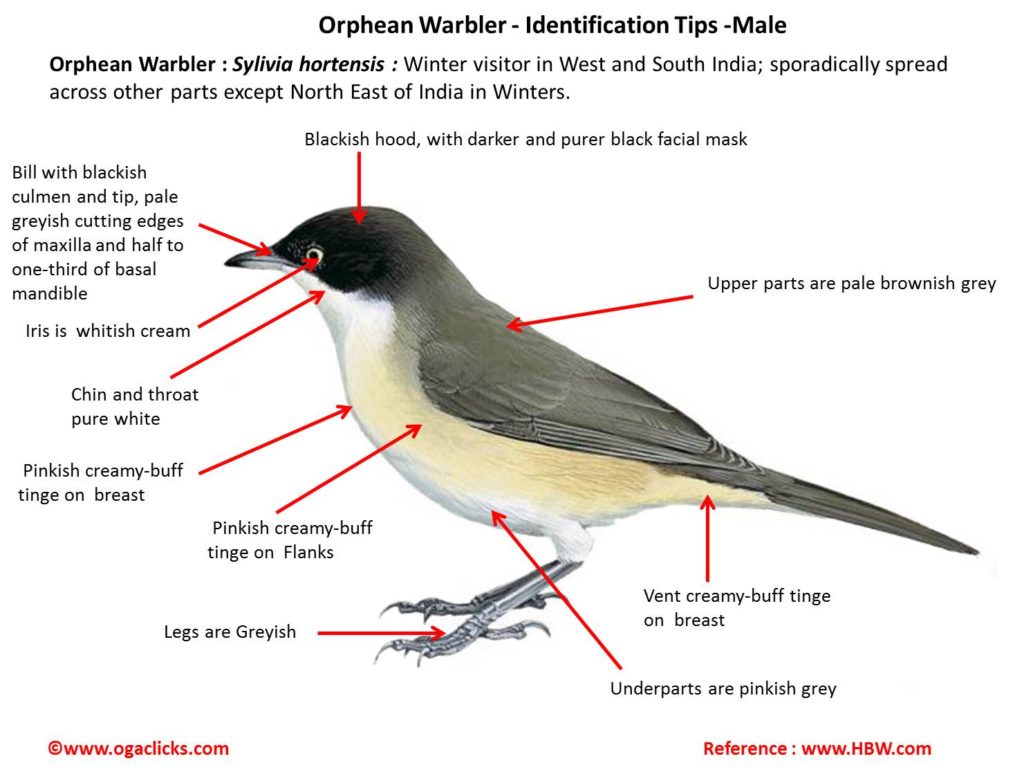Western Orphean Warbler

Orphean Warbler Sylvia hortensis
Etymology:
- Sylvia : Latin word for “woodland sprite, little bird, warbler “
- Hortensis : Latin word for “ of the garden” derived from hortus- garden
Vernacular Name: Baluchistan: Gaz burruck, Pun: Saleti piddi, Guj: Moto shveta kantha, Shyam sharir sweth kanth, Mar: Kaltop vatvatya, Te: Pedda nalla kampa jitta
Distribution in India: Winter visitor in North, West and South India.
Description: Size of 15 cm; wt. of 14·6–35 g. It is a rather large and heavy Sylvia warbler with moderately long tail and wing, and a long, pointed bill. The male of nominate race has blackish hood, usually with somewhat darker and purer black facial mask. The upperparts are pale brownish-grey, merging with blackish hood on nape; remiges and upperwing-coverts are blackish-grey with pale grey to greyish-brown fringes. The alula is blackish, smaller feathers with broad greyish-brown fringes, largest one narrowly fringed whitish. The tail is greyish-black, well-demarcated white edges and tip on outermost feather covering fringe on outer web, moderate edge on inner web, white top on adjacent two rectrices. The underparts are mostly whitish, purer white on throat and mid-belly, marked pinkish, creamy-buff tinge on breast side, flanks and vent. The undertail-coverts are pinkish-grey, slightly paler grey fringes. The iris is whitish-cream sometimes with diffuse brownish dots, orbital ring is blackish-grey to blackish, eyering is largely blackish. The bill is with blackish culmen and tip, pale greyish cutting edges of upper mandible and half to one third of basal lower mandible. The legs are greyish. The female resembles male but browner above, more intensely suffused buffish-brown and less pinkish below, head is distinctly paler and more concolorous with mantle, mostly medium-grey, often with darker ear-coverts and paler lores. The iris is dull pale yellowish, eyering with greyish and white feathers. The juvenile is buffish greyish-brown above, buffish-brown below except for whiter throat, has pale edges and tips of tail feathers reduced and with distinct creamy suffusion, iris is dark brown to olive-brown, orbital ring is brownish-grey to blackish-grey, eyering is mostly white. The first-winter resembles female, distinguished by juvenile-like unmoulted flight-feathers and bare parts. The races differ mainly in colour tones and bill size: crassirostris male has somewhat darker hood and longer bill than nominate, is much purer grey above, whitish below, with dark-centred undertail-coverts; balchanica is similar, but with slightly paler underparts and greyer upperparts; male jerdoni is palest, with still greyer upperparts and whiter underparts, also more extensively black hood and longest bill.
Habitat: It is found in various types of open or semi-open woodland with variable bushy cover, abandoned orchards, suburban gardens, and forested margins of vineyards and ravines. It is found from 800m-2500m during breeding. In non-breeding it inhabits various semi-arid savanna and steppe-like habitats with sparse tree cover and some scrubby vegetation, woodland or scrub.
Food habits:It eats arthropods, insects and their larvae like spiders, ticks, grasshoppers, cockroaches and mantises, stick-insects, bugs, moths, flies, sawflies and ants, beetles, snails and earthworms. It also eats berries, seeds, nectar and fruits in non-breeding season. It forages by moving slowly from low scrub to top of trees, gleaning and picking food items from leaves and branches, mostly on external leafy parts; sometimes catches insects directly on ground or by flycatching. It is frequently associated with Woodchat Shrike (Lanius senator) while feeding; often perching in same tree as latter.
Breeding habits: They breed in Apr to Jul, in South Europe. They are single brooded, monogamous and territorial. The nest is built by both sexes. the nest is a robust cup of grass and plant material with vegetable down, moss and cobwebs, lined with finer grasses and fibres, placed above ground in bush or tree; frequently close to nest of Woodchat Shrike (Lanius senator), even in same bush or tree. They lay a clutch of 3–6 eggs. The replacement clutches are laid after eggs lost. The incubation is by both parents, mostly by female, usually from penultimate egg. The incubation period is 12–14 days. Both parents tend the chicks. The nestling period is 12–13 days. The young are fed by parents for a further 5–6 days after fledging.